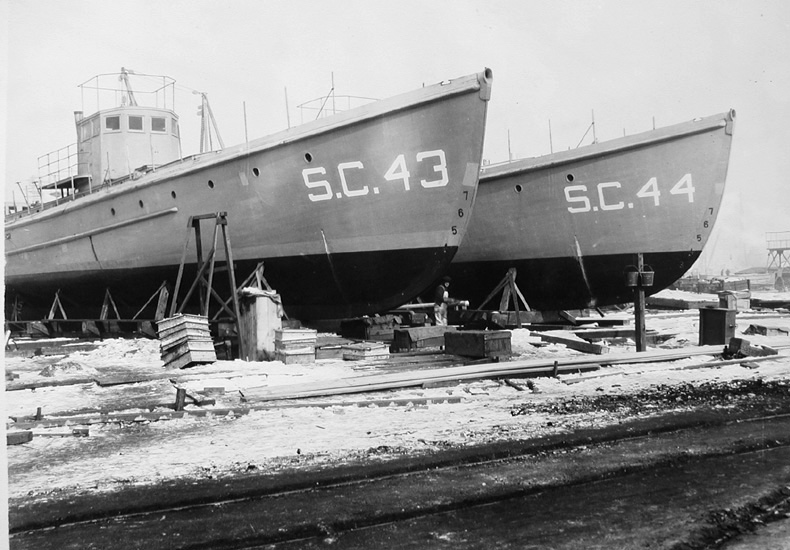“The damage inflicted by U-boats during World War I was powerful. Their ability to submerge and surprise enemies led to massive casualties: Germany and Austria-Hungary sank almost 5,000 merchant ships during World War I, killing approximately 15,000 Allied sailors.” 1
With the ever-increasing potential looming that the United States would join the Allies, the then Assistant Secretary of the Navy, Franklin D. Roosevelt ordered the U.S. Navy in 1916 to design a small anti-submarine vessel that could be built quickly in small civilian boatyards since if war came, major shipyards would be busy building the larger warships. Albert Loring Swasey, an experienced American naval architect, and a Naval Reserve Lieutenant Commander, was tasked with designing a boat to counter the U-boats. While there was initial discussion in using an 80’ wooden boat already in production by ELCO for the British Royal Navy, Swasey chose instead to design a new vessel, 110’ long, weighing 77 tons. (For his wartime contribution in designing and building submarine chasers, Swasey was awarded the Silver Star.) It wouldn’t be long after that as the United States joined the Allies (France, Great Britain, Italy, and Japan) and entered the war on April 6, 1917.

As planned, the construction of the subchasers went out to the smaller shipyards; the average cost of construction was $80,000. Assembled with steam-bent, white oak frames and 11” yellow pine planking, the chasers came to be known affectionately as the Splinter Fleet. The vessels were staffed by 2 officers and 18 enlisted. The propulsion was delivered by three 220hp Standard Motor Construction Company gasoline engines, with three shafts, fed by four 600-gallon fuel tanks. With a speed of 18 knots, they had a range of 1,000nm.
Armament included a 3″ Poole gun mount, two .30-cal machine guns and one depth charge projector, “Y Gun”. They were equipped with the then state-of-the-art hydrophones for detecting the U-boats. The chasers operated in groups of three or six, using a triangulation method to detect the enemy. A total of 441 chasers were built for the war. It is worth noting that the original subchasers, as well as their patrol techniques, would serve as a foundation for the submarine chasers of World War II.
Fast forward to 2020, a friend, who shares a similar interest in local history, showed me a black and white photo of an unidentified pair of Navy boats in Cold Spring Harbor, N.Y. Since it was undated, I presumed they were from World War II. I was mistaken. The only identification was a distinctly Navy typeface hull number “182” stenciled on the bow, but enough to start my research. The Navsource.com website confirmed the identity of the boat as a SC-1 class, a World War I submarine chaser … a member of the Splinter Fleet. This website has photographs of the original crew, during deployment in the North Atlantic and subsequently returning to the States.
The identification of the second boat was recently confirmed when I found another photograph of the submarine chasers at the Cold Spring Harbor Firehouse Museum. This undated photo captured SC-43 in front of SC-182. Both photographs were taken where Abrams Shipyard once operated. Today, the area is Eagle Dock Community Beach.
Records show that the SC-182 was laid down by the International Shipbuilding and Marine Engine Co., Upper Nyack, NY (presently North River Shipyard) and commissioned on April 6, 1918. SC-43 was laid down at the New York Navy Yard, Brooklyn, NY and received her commission a month later on May 16, 1918.
Three years after the war’s end, SC-43 and SC-182 were sold along with other chasers at the Third Naval District Supply Depot, South Brooklyn, N.Y. Other sale locations included Boston, Washington, D.C., Philadelphia, Norfolk, Charleston and New Orleans. Simply stated by the Navy, they were “no longer hunting U-boats and therefore no longer requires the service of these boats” and were being sold “to save the Government cost of maintaining them in idleness”. For prospective buyers, the Sale of Navy Vessels catalog included plans on how the chasers could be converted to yachts or fishing vessels. Suggested uses were: fire, police or harbor patrol, towing, commuter, commercial fishing, pilot boats and passenger ferries, among others.
Both 43 and 182 were sold on June 24, 1921 to Joseph G. Hitner of Philadelphia, PA (Henry A. Hitner’s Sons Company, later known as Hitner Industrial Dismantling Company). SC-43 had an appraised value of $12,600, SC-182 at $11,400. Hitner advertised the boats for sale in Power Boating magazine.
Still a mystery is who brought the chasers to Cold Spring Harbor and why. Aerial photographs from the Suffolk County (N.Y.) The GIS website shows the boats there in 1947 and 1953. Today, at low tide, in the cove near Eagle Dock Community Beach off Shore Road, lays the remnants of a wooden-planked boat. Could this be SC-43 or SC-182? While it may never be determined, both boats spent some of their last days there.
More information about WW1 submarine chasers can be found in the book, Hunters of the Steel Shark: The Submarine Chasers of WW1 by Todd A. Woofenden and the website splinterfleet.org.
1 https://sanctuaries.noaa.gov/news/may18/world-war-i-on-the-homefront.htmlboa
